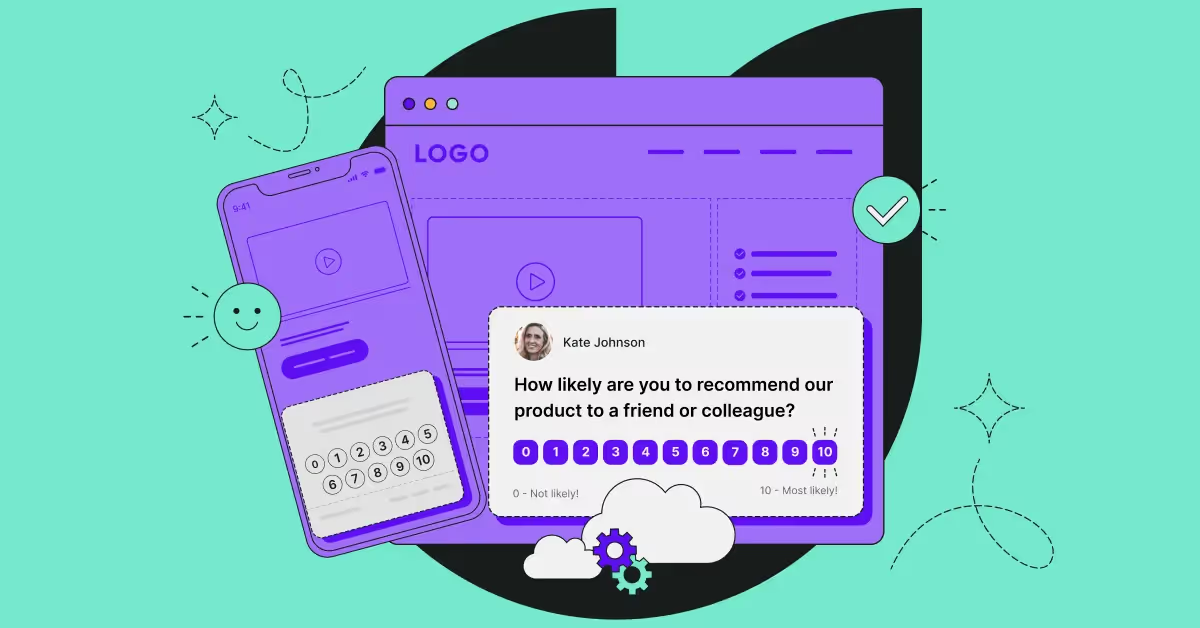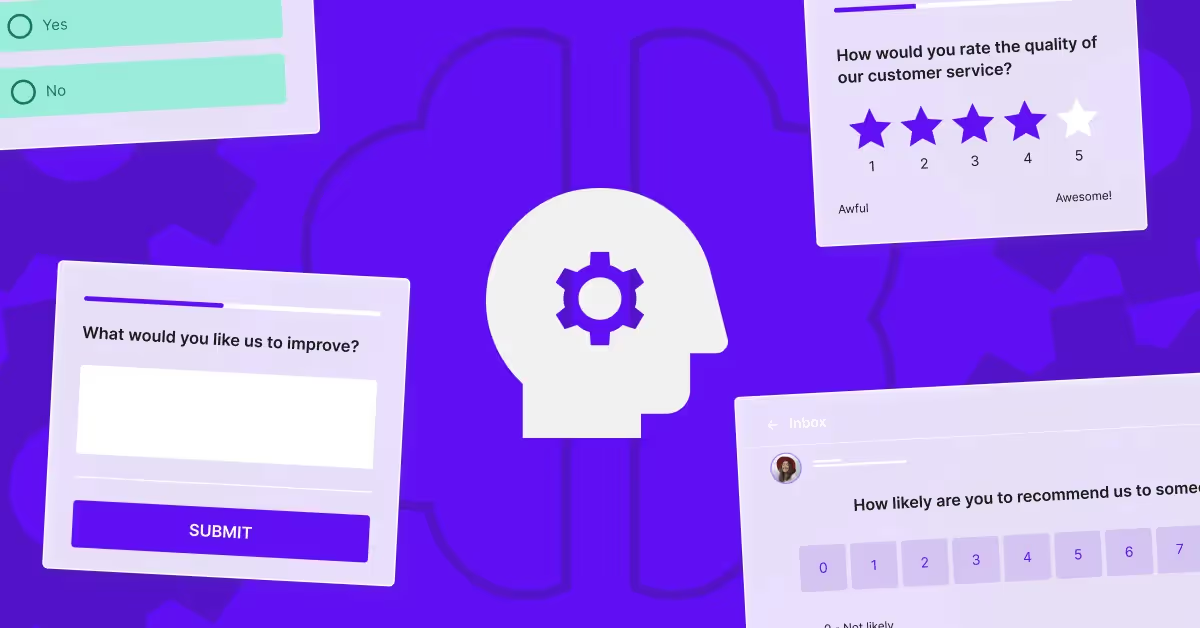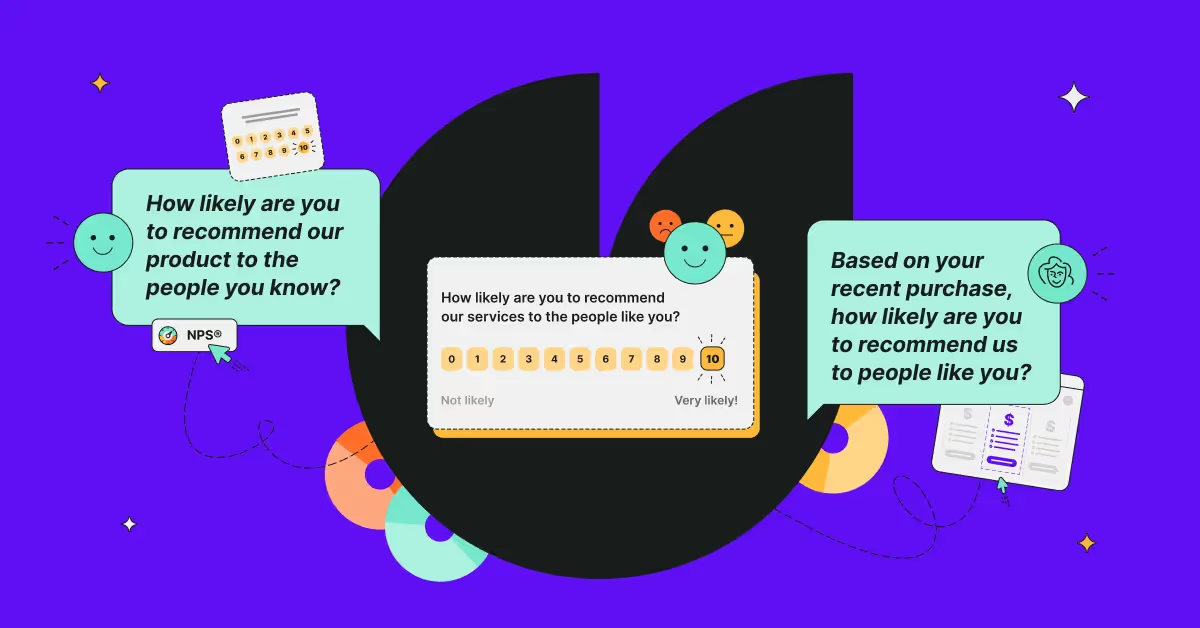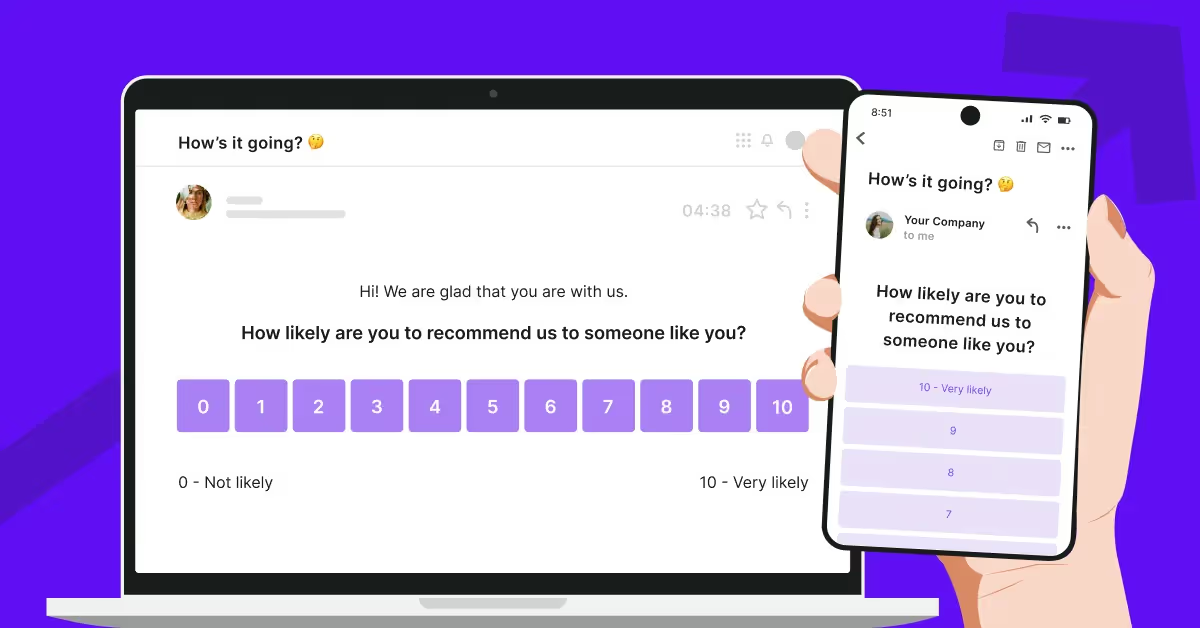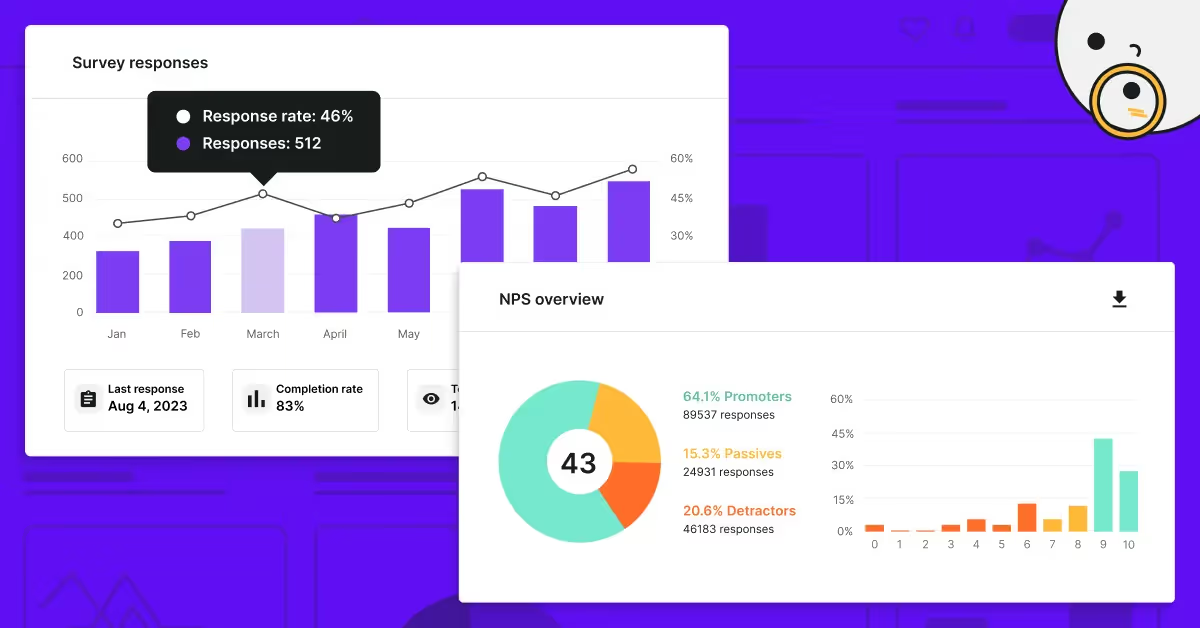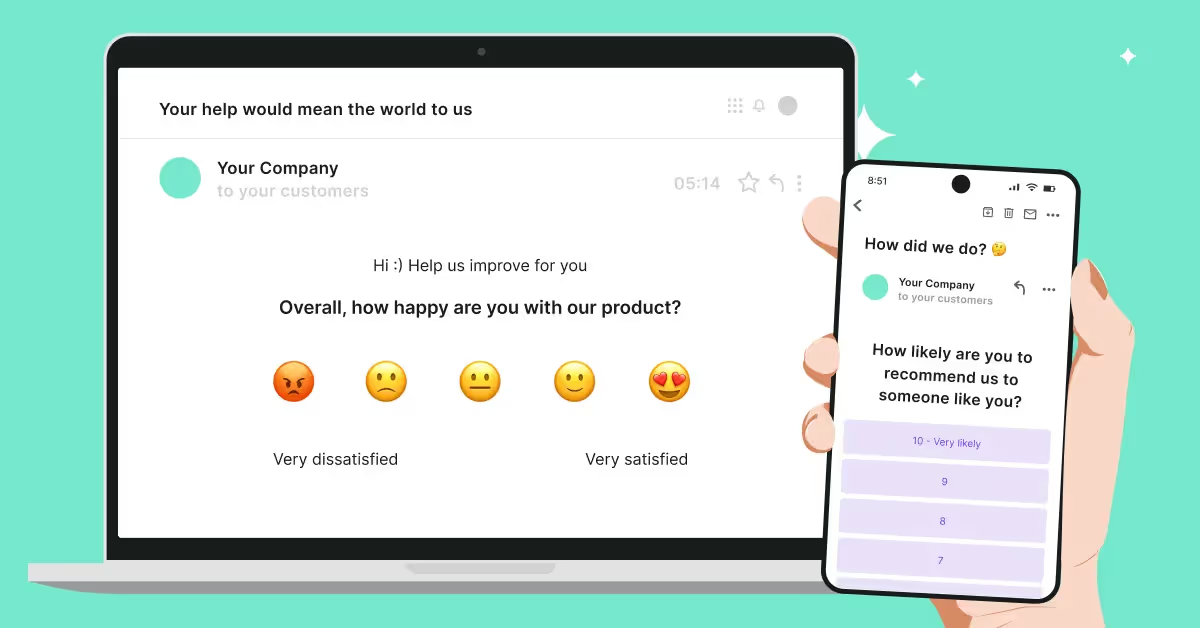Since it was introduced almost 20 years ago, the Net Promoter Score (NPS) has become one of the most popular metrics to gauge customer satisfaction and loyalty.
While NPS is easy to implement and analyze, there are many other tools that can help you supplement NPS findings and provide additional context. Surveys such as Customer Effort Score or Voice of Customer surveys can bypass the limitations of NPS and provide a more comprehensive understanding of your customers’ experience.
In this blog post, we will explore some of the best NPS alternatives to help you enhance your customer experience strategy.

Customer Satisfaction Score (CSAT)
CSAT is a key metric that can help you identify areas where you need to improve your customer experience and address any issues or complaints.
The goal of the Customer Satisfaction (CSAT) survey is to find out how happy your clients are with a recent experience they had with your brand.
In a CSAT survey, respondents can rate their satisfaction with your company on a 1-to-5 scale. You can ask about their general satisfaction with your brand or a particular product or service.
The rating question can be followed by additional, open-ended questions which ask the customer to elaborate on their score.
To calculate your CSAT score, divide the number of respondents who selected four or five on the scale by the total number of respondents. You can then benchmark and track your score over time.
To start measuring your CSAT, simply use the template below:
Customer Effort Score (CES)
Another NPS alternatives is the CES. The Customer Effort Score is a measure of how much effort your customers put into interactions with your company.
The CES question asks customers to rate their effort level on a seven or five-point scale.
Most CES surveys also include an additional, open-ended question that asks for clarification (“What exactly made your interaction with our company difficult?”).
As a transactional customer satisfaction survey, the Customer Effort Score is used right after specific interactions with your company, such as a chat with your customer service representative.
There are no CES benchmarks—some companies choose to apply the seven-point scale and others the five-point one—and it’s difficult to define the average scores.
However, you can benchmark your performance based on historical scores and aim for an average of six or seven (if you use the seven-point scale). If you consistently get scores lower than five, you need to take swift action.
To calculate your CES, divide the sum of your scores by the total number of responses. For instance, if your total score is 400 and you received 100 responses, your CES score is 4.
Here’s a CES survey template you can use when measuring customer satisfaction:
Voice of Customer (VoC)
Voice of Customer is a customizable survey you can use to gather a wide range of feedback points from your customers.
This alternative to NPS allows you to ask your customers about their needs, preferences, and expectations, and it can be displayed on any channel, including email, mobile app, and website.
You can add various question types to your VoC survey, making it a comprehensive tool to gather all the customer data you need to make informed decisions.
The template below consists of an NPS-style question, followed by Likert scale and rating questions. You can use survey logic and arrange them in any order you like.
“Have you ever recommended us” survey
As the name suggests, this survey will help you find out if your customers have referred your company to others. It goes further than the NPS survey, which probes the likelihood of a recommendation.
The “Have you recommended us” survey is a unique and effective way of directly measuring the impact of word-of-mouth marketing on your business.
If a respondent answers with a “no”, they’re asked additional questions to understand the reasons behind their decision. The answers will help you get to the bottom of any issues or complaints.
This variation on the Net Promoter Score survey can be used alongside any other tools listed in this article. You can send it out to your customers using the template below:
Client satisfaction survey for vendors
Survicate’s client satisfaction survey is designed to help you check in regularly with your clients to proactively build successful relationships.
You can fully customize the survey based on your unique needs and include questions such as:
- A standard NPS or CSAT question;
- Rating scale questions to enquire about specific aspects of your clients’ experience with your brand, such as interactions with your customer service and service/product quality;
- A ranking question to prioritize features or aspects of your business in order of importance;
- And an open-ended question to give your clients the space to give you any feedback they want.
If you work on long-term projects, it’s a good idea to send the survey regularly to make sure client satisfaction is consistently high.
💡 YOU MAY ALSO BE INTERESTED IN: Client satisfaction with a project survey template
Customer churn
Watching your customers leave is never a pleasant sight. The silver lining is that you may learn from it. As a results, you can reduce customer churn in the future by getting to the bottom of your customers’ dissatisfaction with your product or service.
A customer churn survey should be quick and to the point. Remember you’re interacting with customers who are not satisfied and who might not be willing to spend time answering lots of questions.
With this type of survey, you can ask your customers why they’re leaving and get them to elaborate on their reason. Survicate’s advanced skip logic function allows you to design a survey experience by adding a customized question flow, just like in the example below:
Help desk survey
Although the help desk survey is not a replacement for NPS, it can support you in your quest to provide the best possible customer experience.
You should send this short survey after an interaction with your help desk team to evaluate its performance and keep track of the customer experience at this vital touchpoint. As a result, you'll be taking steps to improve customer retention and increase sales revenue.
Your help desk survey can help you find out about aspects such as:
- first contact resolution
- waiting time
- problem-solving skills
- product knowledge
- customer handover rates
- call duration
- call success rates
Post-purchase survey
The 80-20 rule, also known as the Pareto Principle, asserts that 80% of your revenue is generated by 20% of your customers.
That’s why taking steps to increase retention is crucial if you want to stay in business.
With a post-purchase survey, you can ask your respondents about anything related to their recent purchase, including how easy it was to place the order, the price, or the delivery method.
It works best when sent or displayed to your customers right after they completed the purchase.
Indispensable for any e-commerce platform, this handy survey will provide you with customer feedback about the best and worst aspects of the shopping experience, helping you to refine the process.
The post-purchase survey works well alongside any other survey on this list to help you create great customer experiences.
Find your NPS alternative with Survicate
While the Net Promoter Score (NPS), the go-to metric for overall customer experience, has plenty of benefits, it’s not without its limitations.
To get a full picture of your customer satisfaction, you need to equip yourself with a range of customer satisfaction tools, all of which should work seamlessly together.
Survicate provides an AI library of over 400 ready-to-send templates that will help you track different aspects of your customer experience. What’s more, you can visualize and analyze your findings in an in-built dashboard and share them with third-party tools via native integrations. If that's not enough, you can also use our AI-powered features—Insights Hub to speed up your feedback analysis, and Research Assistant, a chat ready to answer all the questions you might have about your customers needs or pain points.
Ready to uncover what your customers are really saying? Sign up for a free Survicate account and try our 10-day trial with access to all of the Growth plan features. Don't forget to review our pricing.








